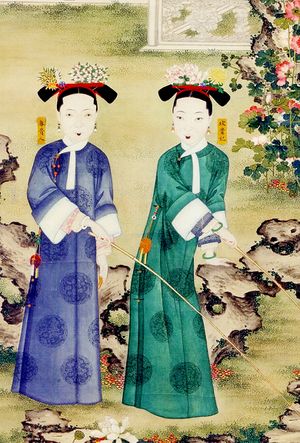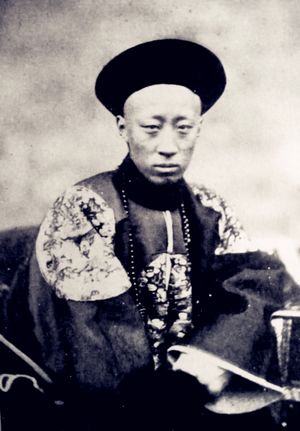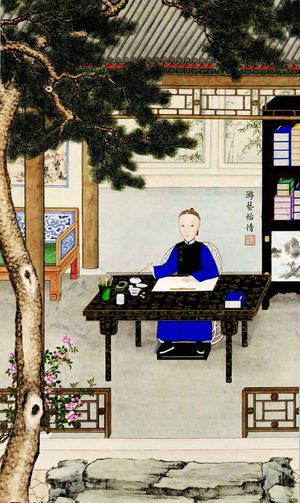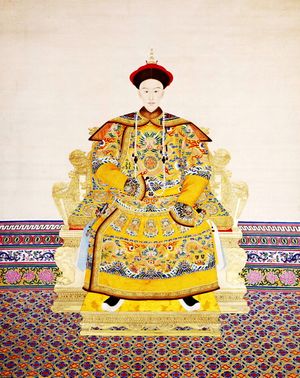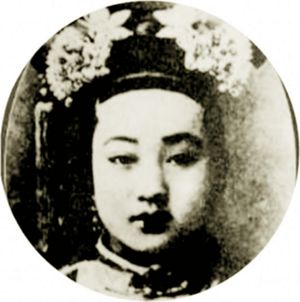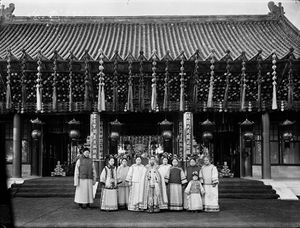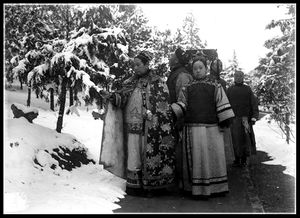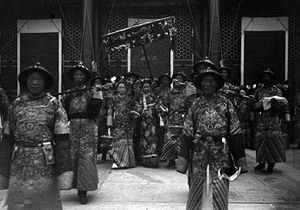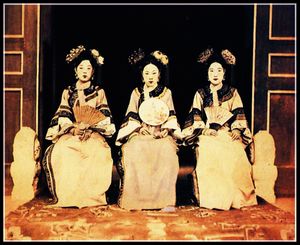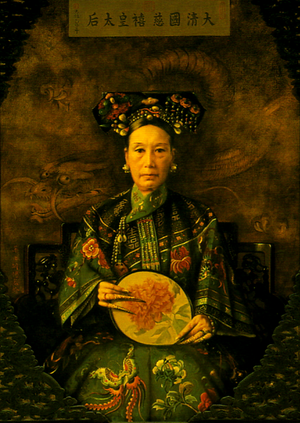الإمبراطورة الأرملة تسيشي
(تم التحويل من الامبراطورة الأرملة تسيشي)
| الإمبراطورة الأرملة تسيشي 慈禧太后 Empress Dowager Cixi | |||||
|---|---|---|---|---|---|
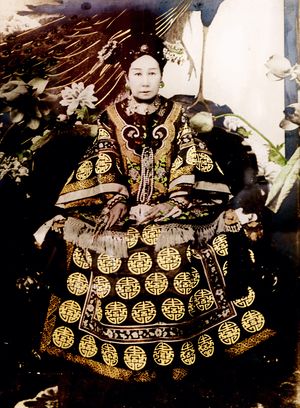 | |||||
| الوصية على عرش أسرة چينگ | |||||
| Regency | 11 نوفمبر 1861 – 15 نوفمبر 1908 في نفس الوقت مع الامبراطورة الأرملة تسيآن (1861–81) | ||||
| سبقه | Sushun, Zaiyuan, Duanhua and other 5 officials as regents for تونگژي الامبراطور | ||||
| تبعه | الإمبراطورة الأرملة لونگيو وZaifeng, Prince Chun كأوصياء على پويي | ||||
| وُلِد | 29 نوفمبر 1835 | ||||
| توفي | 15 نوفمبر 1908 (aged 72) Hall of Graceful Bird, Zhongnanhai, Beijing, Qing Empire | ||||
| الزوج | Xianfeng Emperor | ||||
| الأنجال | تونگژي الامبراطور | ||||
| |||||
| البيت | House of Aisin Gioro (by marriage) | ||||
| الأب | Yehenara Huizheng | ||||
| الأم | السيدة فوتسا | ||||
الإمبراطورة الأرملة تسيشي1، أو الامبراطورة الأرملة تزو-شي Empress Dowager Tzu-hsi (الصينية: 慈禧太后; پنين: Cíxǐ Tàihòu; Wade–Giles: Tz'u2-hsi3 T'ai4-hou4؛ نطق المندرينية: [tsʰǐɕì tʰâɪ̯ xɤ̂ʊ̯]; بالمانچو: Tsysi taiheo؛ إنگليزية: Empress Dowager Cixi؛ عاشت 29 نوفمبر 1835 – 15 نوفمبر 1908)، من عشيرة يهىنارا المانچو، كانت إمرأة قوية ذات شعبية وقد سيطرت بفعالية وإن بشكل غير رسمي على أسرة چينگ المانشو في الصين لمدة 47 عاماً، من 1861 حتى وفاتها في 1908.
السنوات المبكرة
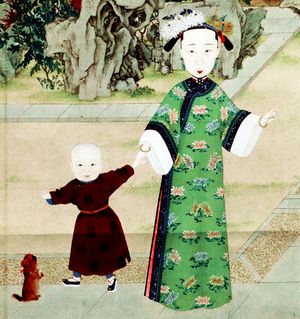
پورتريه مبكر of the old Dowager Consort Kangci, foster mother of Emperor Xianfeng. She hosted the selection of Xianfeng's consorts in 1851, in which Cixi participated as a potential candidate. She supervised the entire process while the emperor himself was not present. Thus, she made every decision on behalf of the emperor. It is widely believed that Cixi made a favourable impression to her on that occasion.
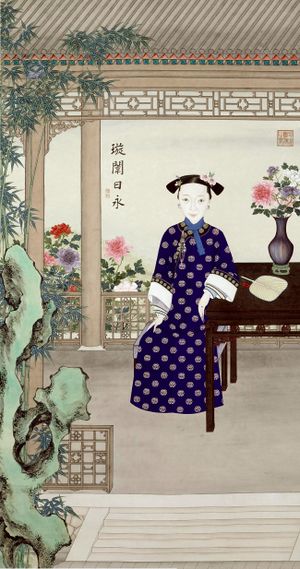
پورتريه of Empress Dowager Ci'an (co-regent with Cixi), with whom Cixi staged the Xinyou Coup. Before the death of Xianfeng, Ci'an was his empress consort while Cixi was his concubine. This fact gave Ci'an precedence over Cixi in all aspects of court life, even though they were both created empress dowagers.
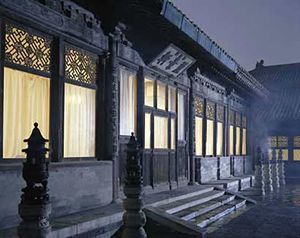
The Pavilion of Beautiful Scenery, inside which Cixi gave birth to the future تونگژي الامبراطور.
انقلاب شينيو: الاطاحة بـ سوشون
وراء الأستار
عصر حديث
انتصار تايپنگ والأمير گونگ
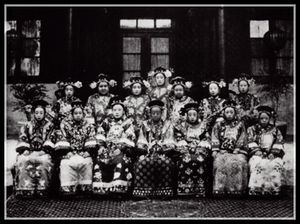
Photograph of Princess Rongshou (center seated), daughter of Prince Gong. As a way to show gratitude to the Prince, Cixi adopted his daughter, and elevated her to the rank of Kurun Princess (the highest rank for imperial princesses). The Princess remained a lifelong friend of Cixi, and earned Cixi's respect and reverence for her forthrightness and sincerity. She became one of the few people whose remarks were taken seriously into account by Cixi.
زواج تونگژي
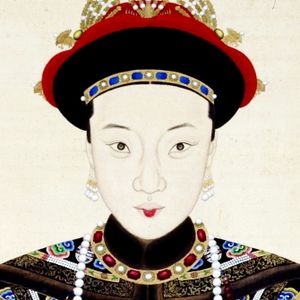
پورتريه لإمبراطورة تونگژي ، whom was chosen against Cixi's will. The Empress never managed to get along with Cixi, and was persecuted both mentally and physically until her death in 1875. When Beijing was occupied by Eight-Power Allied Forces in 1900, the Empress's mother and siblings fell victims to public gang rape by a huge number of foreign soldiers. That resulted in the immediate mass suicide of her entire family.
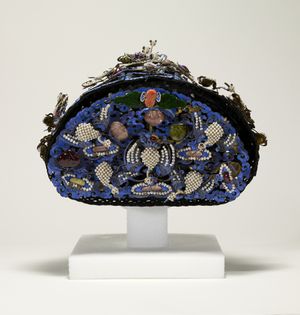
Ceremonial headdress likely worn by Cixi. The small phoenixes emerging from the surface represent the empress. [1] The Walters Art Museum.
مثالب تونگژي في الحكم
الوصاية على الامبراطور گوانگشو
التحديات الجديدة
ارتقاء الامبراطور گوانگشو العرش
اصلاح المائة يوم
انتفاضة الملاكمين واصلاحات چنگ المتأخرة
الوفاة ومقر الدفن النهائي
العائلة
- Paternal Great-Grandfather
- Yehenara Jilang A (葉赫那拉·吉郎阿)
- Paternal Grandfather
- Yehenara Jingrui (葉赫那拉·景瑞)
- Father
- Yehenara Huizheng (葉赫那拉·惠徵) (29 September 1805 – ?), Manchu official of the Blue Bordered Banner, served in Shanxi Province before becoming Commissioner of Anhui
- Mother
- Lady Fuca (富察氏), Huizheng's primary wife, daughter of Fuca Huixian (富察·惠顯)
- Husband
- Xianfeng Emperor, father of the تونگژي الامبراطور
- Son
الأشقاء وأنجالهم
- 1st younger sister: Yehenara Wanzhen (葉赫那拉·婉貞) (13 September 1841 – 19 June 1896), married Yixuan, Prince Chun
- 1st son: Zairong (載瀚) (1 February 1865 – 9 December 1866)
- 2nd son: Zaitian (載湉) (14 August 1871 – 14 November 1908), became the گوانگشو الامبراطور
- 3rd son: unnamed (13 February 1875 – 14 February 1875)
- 4th son: Zaiguang (載洸) (28 November 1880 – 18 May 1884)
- 2nd younger sister: Lady Yehenara (葉赫那拉氏), married Yixun (奕勛) (second younger brother of Yikuang, Prince Qing)
- 1st younger brother: Yehenara Zhaoxiang (葉赫那拉·照祥)
- Son: Yehenara Deshan (葉赫那拉·德善)
- 2nd younger brother: Yehenara Guixiang (葉赫那拉·桂祥)
- 1st daughter: Yehenara Jingrong (葉赫那拉·靜榮), married Zaize, Duke of Zhen in 1894
- 2nd daughter: Yehenara Jingfen (葉赫那拉·靜芬) (1868 – 22 February 1913), married her first cousin, the گوانگشو الامبراطور on 26 February 1889 and became Empress Dowager Longyu (known posthumously as Empress Xiao Ding Jing)
- 3rd daughter: Yehenara Jingfang (葉赫那拉·靜芳), married Zaiyi
- Son: Pujun (溥儁) (1885–1942)
- 1st son: Yuwei (毓巍) (September 1908 – May 1998)
- 1st son: Henglu (恆祿)
- 2nd son: Hengyu (恆玉)
- 3rd son: Hengjun (恆均)
- Son: Luowei (羅偉)
- 2nd son: Yuling (毓嶺)
- 1st son: Yuwei (毓巍) (September 1908 – May 1998)
- Son: Pujun (溥儁) (1885–1942)
- 1st son: Yehenara Deheng (葉赫那拉·德恒), courtesy name Jianting (健亭)
- 1st daughter: Yehenara Shumin (葉赫那拉·淑敏)
- 2nd daughter: Yehenara Shuqin (葉赫那拉·淑琴)
- Son: Yehenara Enxian (葉赫那拉·恩賢)
- 2nd son: Yehenara Deqi (葉赫那拉·德祺), courtesy name Shouzhi (壽芝)
- 1st daughter: Yehenara Xixian (葉赫那拉·希賢)
- 2nd daughter: Yehenara Xiyan (葉赫那拉·希嬿)
- 1st son: Yehenara Enyin (葉赫那拉·恩印)
- 2nd son: Yehenara Enxian (葉赫那拉·恩顯)
- 3rd son: Yehenara Enmin [ك] (葉赫那拉·恩民)
- 4th son: Yehenara Enzhi (葉赫那拉·恩植)
- 3rd younger brother: Yehenara Fuxiang (葉赫那拉·福祥)
- Son: Yehenara Dekui (葉赫那拉·德奎), courtesy name Wenbo (文伯)
- 1st daughter: Yehenara Enhua (葉赫那拉·恩華)
- 2nd daughter: Yehenara Enxiu (葉赫那拉·恩秀)
- 1st son: Yehenara Enquan (葉赫那拉·恩銓)
- 2nd son: Yehenara Enhui (葉赫那拉·恩輝)
- 3rd son: Yehenara Enyao (葉赫那拉·恩耀)
- 4th son: Yehenara Enguang (葉赫那拉·恩光)
- Son: Yehenara Dekui (葉赫那拉·德奎), courtesy name Wenbo (文伯)
- 1st younger sister: Yehenara Wanzhen (葉赫那拉·婉貞) (13 September 1841 – 19 June 1896), married Yixuan, Prince Chun
أسماء الإمبراطورة الأرملة تسيشي
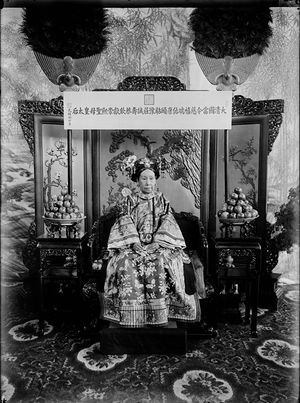
The plaque hanging above Cixi is inscribed with her title in full, literally translated as "The Current Holy Mother Empress Dowager of the Great Qing Empire, Cixi (kind and auspicious) Duanyou (upright and blessed) Kangyi (healthy and well-maintained) Zhaoyu (clear and pleasant) Zhuangcheng (solemn and sincere) Shougong (long-living and respectful) Qinxian (royal and sacrificial) Chongxi (magnanimous and prosperous).

The Empress Dowager was a devoted Buddhist and seized every opportunity to dress up as Avalokiteśvara, the Goddess of Mercy. This photograph shows her in her Buddhist outfit sitting on a barge in the Kunming Lake of the Summer Palace. The white smoke forms the character for longevity, and on top of the smoke was her Buddhist name "Guangrenzi" (literally Universal Benevolence).
آراء تاريخية
التعاقب
| الملكية الصينية | ||
|---|---|---|
| سبقه Empress Xiaojingcheng |
Empress Dowager of China 1861–1908 concurrently with Empress Dowager Ci'an: 1861–1881 |
تبعه Empress Dowager Longyu |
انظر أيضاً
- Ranks of Imperial Consorts in China#Qing
- Qing Dynasty nobility
- Imperial Decree of declaration of war against foreign powers
- Imperial Decree on events leading to the signing of Boxer Protocol
في الثقافة الشعبية
- Pearl S. Buck's novel Imperial Woman chronicles the life of the Empress Dowager from the time of her selection as a concubine until near to her death. Empress Dowager Cixi is portrayed as a stern, motivated woman who stands to the old ways of life and government and resists the changes brought by westerners. Empress Dowager Cixi's actions on behalf of the two Emperors that she raised and her own actions are all accounted for and rationalized as being for the good of her people and her country.
- The novels Empress Orchid (2004) and The Last Empress (2007), by Anchee Min portray the life of Empress Dowager Cixi from a first-person perspective.
- The Noble Concubine Yi is featured in George McDonald Fraser's novel, Flashman and the Dragon (1985).
- The 1968 novel Wij Tz'e Hsi Keizerin Van China (We, Tz'e Hsi, Empress of China) by Dutch author Johan Fabricius is a fictional diary of the Empress.
- Cixi is portrayed by actresses Flora Robson in the 1963 film 55 Days At Peking and by Lisa Lu in the 1987 film "The Last Emperor".
- Forbidden City: Portrait of An Empress, a Singapore musical that tells the story of Empress Dowager Cixi, was staged by the Singapore Repertory Theatre originally on 17–19 October 2002.
- The China Central Television production Towards the Republic portrayed Empress Dowager Cixi as a capable ruler, albeit not entirely positive, for the first time in the history of Mainland Chinese television, although it also clearly demonstrated her political views as very conservative.
الهامش
للاستزادة
- Chung, Sue Fawn (1979). "The Much Maligned Empress Dowager: A Revisionist Study of the Empress Dowager Tz'u-Hsi (1835–1908)". Modern Asian Studies. 13 (2): 177–196.
- Hummel, Arthur William, ed. (1943). Eminent Chinese of the Ch'ing Period (1644–1912). 2 vols. Washington: United States Government Printing Office.
- Warner, Marina (1972). The Dragon Empress: Life and Times of Tz'u-hsi 1835–1908. Weidenfeld & Nicolson.
- Hayter-Menzies, Grant (2008). Imperial Masquerade: The Legend of Princess Der Ling. Hong Kong University Press.
- 雷家聖(Lei Chiasheng) (2004). 《力挽狂瀾-戊戌政變新探》,台北:萬卷樓. ISBN 957-739-507-4.
وصلات خارجية
- Cixi – Biography of Dowager Empress of China Cixi or Tz'u-hsi at womenshistory.about.com
- Royalty.nu – Chinese History – Dowager Empress Tzu Hsi or Cixi at www.royalty.nu
- http://www.kings.edu/womens_history/tzuhsi.html
- http://www.fordham.edu/halsall/eastasia/headland-courtlife.html
- Princess Der Ling at solongletty.tripod.com
- Cixi: The Woman Behind the Throne – Smithsonian.com
الكلمات الدالة:
This article contains content from Wikimedia licensed under CC BY-SA 4.0. Please comply with the license terms.
تصنيفات:
- Short description is different from Wikidata
- Articles containing Chinese-language text
- Pages using template Zh with sup tags
- Articles containing إنگليزية-language text
- Pages using Lang-xx templates
- Persondata templates without short description parameter
- مواليد 1835
- وفيات 1908
- Qing Dynasty imperial consorts
- Qing Dynasty empresses
- Qing empresses dowager
- منچو (شعب)
- Chinese people of the Boxer Rebellion
- Chinese regicides
- وصيات على العرش
- Qing Dynasty regents
- زعيمات الصين
- Concubines
- 19th-century Chinese people
- 19th-century viceregal rulers
- 19th-century female rulers
- أشخاص من بـِيْجينگ
